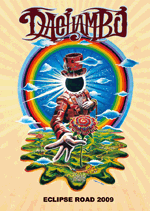The New Groove 日本の移民問題
|
Why is Japanese music so patently bad?
It’s a topic I’ve heard discussed in numerous circles—academic, musical or otherwise. Japanese enthusiasts of world music often agree. Partially underscoring this, Japanese music charts regularly include foreign artists while charts in the U.S. and Europe never seem to include Japanese music. Even New York-raised Japanese pop diva Utada Hikaru’s foray into the U.S. music scene led nowhere. Not that charts are the litmus test of quality or that the West can claim the abiding standard for musical quality, either. But still, so much of what seems accomplished, original and distinctive in modern music comes from there, not here. We all know the main culprits. Record companies in Japan churn out ‘hit’ after hit from the same producers processing stale beats and trite melodies for pre-packaged glam troupes with nausea-inducing names. Image is all, and all, nil. Bands that actually play their own instruments compose songs to established—no, exhausted sounds and tastes. Too many ‘artists’ are simply trying to fulfill expectations, and expectations are low. Very low. Let’s invoke a little historical fatalism. Japan has been, since at least the late 19th century (and more than 1000 years earlier for that matter), a remarkably adept cultural imitator in addition to innovator at times. Its very brief transition from feudalism to a modern society was enabled by an unprecedented campaign of copycat-ism. Habits engendered from that frenetic initiative are still pervasive today. Why shouldn’t Japan’s music seem so derivative? “It can’t be helped,” as the staple phrase goes. I don’t completely subscribe to this hypothesis by any means, but I can affirm that a robust spirit of creativity is notably absent from many corners of Japanese society, especially the educational system. I’ve been in Japan for ten years—ten deep years—and I am still continually surprised and flabbergasted by this. It’s a country too often chained to formula and rule. There are some rule breakers and exceptions, many more than I am probably aware of, I admit. Certainly, Japan has given the world some doses of greatness. Sakamoto Ryuichi comes immediately to mind. Or jazz impresario Suzuki Isao. Classical guitarist Muraji Kaori occupies an elite league (though playing Western music). Traditional Japanese music (shamisen, koto, etc) also has significant claim to world music heritage. What about more mainstream music? Oyamada Keigo (Cornelius) constantly breaks new ground. Soul Flower Union (interviewed in Koe #2) defy genre with innovative hybrid sounds. Japanese punk continues to produce notables like Midori and the small-venue concert circuit sees countless promising, often unsigned, acts come along. Maybe we should also tip ours hats to veteran pop-rock bands like Mr. Children and Southern All-Stars for thriving through the decades. Longevity, as noted later, may count for more than we think. 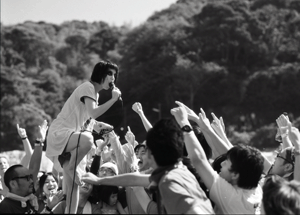
Midori can really rile up her audiences. Here, diving into the fans at Sunset Live, Fukuoka, 2009. The paucity of inspired and inspiring artists with a distinct sound nevertheless remains. It might be instructive to quote Basho’s famous gem: “Don’t imitate the masters. Seek what they sought.” Who is pursuing sublimity these days? Who achieves the sublime? I’m excited about the recent trend of excellent Japanese bands and artists pushing back in greater numbers against the old norms and detritus of ditties. Instead of top-down, multi-million dollar promotion campaigns from huge record companies, they are building their fan-base grassroots style—through devoted touring and festival participation. Many are aided by websites like MySpace, YouTube and i-Tunes, which are sounding the death knell of some record companies, much more so than music theft, I suspect. The best of these bands are also great improvisational players. The best of them? I’m certainly partial to good live acts, but how much is personal taste really an issue here? On a certain collective level, and over time, it’s everything. In his essay, “What is a Classic” from Other Shores, Nobel laureate J.M. Coetzee lays out a convincing argument for why Bach’s music is “classic.” Tweaking Horatio’s claim that, quite simply, a classic is what survives, Coetzee explains what it must survive and by what means. Bach survived decades of public obscurity (including the last years of his life) because other composers performed and appreciated his work in private circles. His music withstood the critical scrutiny of professional peers and their protégés until it was brought out to the public again generations later. We often refer mockingly to “the gatekeepers of high culture,” but their piercing, and ultimately healthy, criticism can ensure tradition. Taste—the refined taste of committed practitioners of the art—weaves together with the cycles of popular taste to define, over time, the classic. It’s important, however, to recognize some artists as individuals who capture the spirit of an age, rather than musical greatness. In Japan, Misora Hibari sings skillfully enough, but is an icon of immediate post-war culture before she is a vocalist. Our appreciation of music with the patina of history is closely tied to our nostalgic tendencies. We call her songs—and Sinatra’s—classics, and maybe they are, but when the generation that grew up connecting its memory of these artists to the ethos of that age is gone, will such artists fade like an echo? Compare them to Robert Johnson. He died at the age of 27 with a scant 29 songs to his name and little contemporary fame. His ‘rediscovery’ by mainstream artists like Eric Clapton helped establish modern blues rock. Clapton has commented in interviews on Johnson’s “weirdness,” or what we might rephrase as the uncanny art of his songs, and Clapton’s simplification of covers like “Walking Blues” comes as a backhanded compliment to Johnson’s sophistication. Bands continue to perform him and director Martin Scorsese paid homage to the genre of which Johnson is king with a landmark documentary. The jazz and blues tradition is largely about reinterpreting older tunes, true, but that ceaseless performing of the collective repertoire means the gems stay hard and polished. 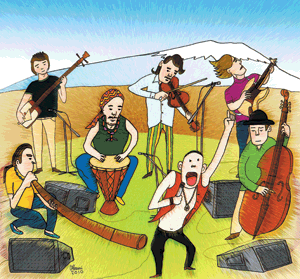
Illustration by Shinohara Akemi What role do lyrics play? The scope of the question is enormous and the answer is relative. Complicating the issue is that we can appreciate lyrics independent of music. Many professors of literature call Bob Dylan the best American poet of his day. Leonard Cohen, too, is good on paper. But are lyrics even necessary? Obviously not. Obviously so in opera and rap. Ultimately, lyrics are the artist’s prerogative but they can without a doubt enhance the aesthetic effect, especially when sung by careful design. Listen to Jeff Buckley singing Cohen in “Hallelujah.” You get the point. Listen to Love Psychedelico’s mesmerizing vocals in English and Japanese in “Last Smile.” You get the point. Coetzee’s essay also makes implicitly clear the importance of live performance. Bach’s admirers didn’t simply read his scores and pass around copies. They performed in their parlors. Music should be experienced live for full appreciation. We all know this intuitively. And all performers know that the collective vibe of the audience can push them, and the performance, to another level. The “high gear of the soul,” as Phish—a quintessential jam band that understands this well—sings it. It’s no accident that good artists and bands, the ‘best of them,’ sound much better live than recorded, and it’s not any producer’s fault. Nothing beats a good live gig. Obviously, all the old paradigms have been overturned in recent years by disruptive technology and other social trends. Since Napster, people have been ‘sharing’ files instead of sharing music in private parlors. “Mashups” from DJs appear on the internet, like Danger Mouse’s “Grey Album,” featuring Jay-Z’s Black Album crossed with the Beatles’ White Album. Chip advances and powerful programs have lowered the barriers to excellent home recording and private studios. Decades ago, the Grateful Dead encouraged live taping and cassette trading at their shows. Some bands continue that practice today, though websites now allow fans to digitally download the shows later. Song covers seem even more common in recent decades, but hardly any of them surpass the originals anymore. Occasionally, someone like pianist Brad Mehldau will come along, take Radiohead’s “Knives Out,” and give us an equally accomplished song. Most other covers seem intended merely for profit. Tribute albums are equally dubious. The fairly recent tribute album to accomplished singer-songwriter Yamazaki Masayoshi, with artists like Hajime Chitose singing his somber “Namae no nai tori,” may make the grade, but these projects are generally conceived of by record companies, not admiring artists themselves. Finally, in an intriguing so-called “post-modern” trend, notions of genre are collapsing and traditions are blending. The Yoshida Brothers mix Tsugaru-jamisen with various world music styles. Dragon Ash, which puts on a powerful live show, mixes rock and rap with Latin beats and rhythms, as on their album “Independiente.” UA sings well to just about any background music, with praise equally due her top-notch producers—her collaborative album “Nephews,” with its creepy-cool cover of the Rolling Stones’ “Missing You,” is a great achievement. Rappers Run DMC and rockers Aerosmith performing “Walk This Way” together decades ago were harbingers indeed. So where is Japanese music heading? Like all world music: in multiple directions. But in the pages that follow, I highlight three bands I think are going to the distance as they blaze new paths, possibly even becoming ‘classics.’ They are conscious of the multitude of musical traditions that have preceded them and seem to envision a clear, ambitious direction for their own music. They have the improvisational skills to make each live show unique and can go supernova on stage when conditions are right. In the spirit of professional criticism that invigorates artistic traditions, I feel compelled to lodge some concerns. Those, however, are few. In many ways, these bands are also working against assumptions and expectation—that Japanese music can’t deliver on the level of the West’s best. Anyone with an ear may rethink this. “The times they are a-changing.” These leaders of the new groove are patently good and getting even better. (Ry Beville, an amateur guitarist, studied song and lyric composition under Pulitzer-prize winning composer William Bolcom and former U.S. poet laureate Robert Hass. He is currently writing his dissertation on Japanese poets and lyricists from the Meiji and Taisho periods) |
日本の音楽業界はなぜダメなのか。
この話題を今までいろいろなところで聞いてきた。今でも業界人の集まりの場、音楽ファンの間でもよく話題に上る。洋楽のファンたちは、日本の音楽チャートには外人アーティストがいつも入っているのに欧米のヒットチャートに日本人アーティストがチャートインすることはゼロに近いという事実から見ても日本の音楽はダメだ、という。ニューヨーク育ちの宇多田ヒカルでさえアメリカ進出は成らなかった。ヒットチャートに入るか入らないかだけで音楽の質が決まるものではないし、音楽の質を決める不変の基準のようなものが欧米にあるというわけでもないが、世界の一流と言われる音楽家たちのほとんどは欧米出身者で、日本から出た世界の一流は限りなく少ないというのも事実だ。 その大きな原因は、日本のレコード会社のやり方にあるといわれている。変わりばえしないプロデューサーによって、若者にウケの良さそうなリズムとメロディーのを組み合わせで、軽薄な名前を付けたダンスグループが売り出される。イメージが全てであり、そこには音楽的な価値というものは存在しない。実際に楽器をプレイするバンドのオリジナルソングでさえ目新しいものは無くどこかで聞いたようなものばかり。「アーティスト」と称するほとんどの人たちはファンの期待に応えることしか考えていない。そしてファンたちの「期待」がとにかく低レベルなのである。 日本の芸術文化の歴史を見てみよう。少なくとも19世紀の終わり以降、あるいはもっとずっと昔からだったともいえるが、日本はたまに革新的なことをすることもあったが、基本的には海外の文化を取り入れ、それを模倣することに専念してきた。江戸時代から明治に掛けて、かつてない模倣文化の大きなうねりの中で日本は封建制度から近代社会へと移行していった。当時熱心に海外文化を模倣した者たちの精神は今日の日本にも広く浸透している。そんなわけだから日本の音楽が大抵欧米の音楽の真似に聞こえてしまうのは仕方のないことかもしれない。少なくとも僕が確信を持って言えるのは、豊かな創造の精神というものが日本社会、特に日本の教育制度に欠如しているということ。僕は日本に来て10年になるけど、今でも日本の教育方針には驚くことが多い。あまりにも形式や決まり事に縛られすぎだと思うのだ。 しかし例外が存在することも事実。例外を何人か知っているけど、僕が知っている人たち以外にもたくさんいるはずだ。確かに過去、日本から何人か優秀な音楽家が出ている。まず思い浮かぶのは坂本龍一。ジャズの鈴木勲。クラシックギターの村治佳織。また、三味線や琴など、日本古来の楽器で演奏される音楽は、日本が世界に誇れる伝統音楽である。最近の音楽では、コーネリアス名義で活動を続ける小山田圭吾の新しい試みは注目に値するし、「声」マガジンの第2号でも特集したソウル・フラワー・ユニオンは様々なジャンルの音楽を吸収・消化した独自の音で、どの音楽ジャンルにも収まらないユニークな活動を展開している。日本のパンクミュージック・シーンもミドリなどの有能なバンドを輩出し、まだレコード会社と契約していない、将来有望なバンドたちがライブハウスで日々熱い演奏を繰り広げている。また、ミスター・チルドレンやサザン・オール・スターズなど大御所バンドの長年にわたる活躍も忘れるわけにはいかない。後にも触れるが、長く続けるということがとても重要なことかもしれない。 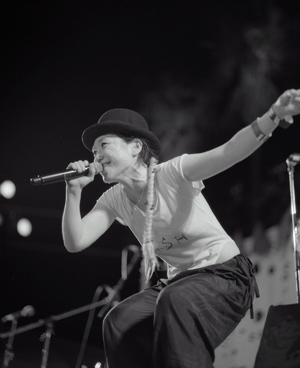
Nakano Yoshie of Ego Wrappin’ has been singing strong for over a decade そうは言っても、「本物」がまだまだ少ないのも事実。本物の気高さを持ち、崇高な音を求めているアーティストはいったい誰か。誰がそれをやり遂げるのか。その答えのヒントは芭蕉のよく知られた言葉に見いだせるかもしれない。「古人の跡を求めず、古人の求めたるところを求めよ」。 最近日本でも気概を感じさせるバンドやアーティストがちらほら出てきていることはとても嬉しいことだ。大手レコード会社による大掛かりなプロモーションに頼ることなく、ライブをこまめに行い、野外フェスやイベントなどにも積極的に参加していくという、いわば草の根的な活動を展開しているアーティストたち。レコード会社にとっては大きな脅威となってきている「My Space」「You Tube」「i-Tunes」といったネット媒体もこのような草の根的活動を続けるアーティストの強力な味方となっている。このようなアーティストたちの中には本当に素晴らしい演奏をするプレイヤーがいる。 誰が一番素晴らしいかって?確かに僕はよく好きなアーティストのライブを見に行く。僕の個人的な好みの話はどうでもいいだろう、と思われるかもしれないが、実は個人的な好みが長い目で見ればすべてを決める、とも言えるのだ。 ノーベル文学賞を受賞したJ・M・クッツェーは「古典とは?」というエッセイの中で、なぜバッハが古典とされているのかということについて面白いことを書いている。ホレーショは端的に「古典とは末長く残るものをいう」と言ったが、クッツェーはどんな芸術がどうやって残っていくのか、ということについて書いている。バッハはその生存中も、そして死後しばらくの間も無名だった。彼の作品は後に改めて世間に紹介されるようになるまでの長い間、音楽仲間や評論家たちの冷たい目や批評に耐えて生き残った。しかし彼らの、辛辣だが感性豊かな批評が古典を守ってきた、ということもある。芸術に本気で取り組んでいるアーティストたちの洗練された感覚が一般大衆の嗜好の移り変わりと共に、やがて古典と言われるようになるものを定義してゆく。 一方で、音楽的なレベルはさほど高くなくても時流に乗って成功しているアーティストも実際に居る。例えば美空ひばりは優れた歌唱力を持った歌手だったが、歌手であるという前に、終戦直後の日本の雰囲気を象徴する存在だった。古典を愛する気持ちは我々が心の中に持つ郷愁の念と深く結び付いている。美空ひばりは歌謡界の古典ともいわれるが、では彼女の歌を聴きながら育ってきた世代がいなくなった時、彼女は忘れ去られてしまうのだろうか。ロバート・ジョンソンというブルース・アーティストは自身の作品として29曲しか残さず、しかも当時はあまり注目されることもなく27歳の若さで死んだ。死後、エリック・クラプトンを始めとした有名アーティストがジョンソンの曲を取り上げたことが今日のブルース・ロックといわれるジャンルを作り上げたと言われる。クラプトンはインタビューの中でジョンソンの曲はとても変わっている、と言っているが、実際彼の音楽は素晴らしい芸術であり、クラプトンによるカバー曲「ウォーキング・ブルース」のシンプルなアレンジはジョンソンの芸術性の素晴らしさに対する云わば「ほめ殺し」と解釈できる。ジョンソンの死後、彼の曲は多くのバンドによって演奏され、映画監督のマーティン・スコセッシはジョンソンを取り上げたドキュメンタリー作品を制作した。ジャズやブルースは古い曲の再解釈として演奏されることがほとんどだが、そうして繰り返し演奏され歌い継がれていくことによって、優れた作品がまたさらに洗練されてゆく。 
Furuya Kenji, of Dragon Ash, whose live show packs some power 歌詞の役割は何だろう?我々は楽曲に関係なく歌詞だけが好きだったりすることもあるので、この問題は複雑だ。ボブ・ディランがアメリカの最高の詩人であることは多くの人が認めるところ。レナード・コーエンもファンが多い。しかし歌詞がない楽曲は存在し得ないか?もちろんそんなことは無いがオペラやラップ・ミュージックは歌詞が無いと始まらない。歌詞はアーティストの云わば特権のようなものだが、特に何らかの意図をもって丁寧に歌われる歌詞は楽曲を美しく彩りその価値を高める。ジェフ・バックリィによるレナード・コーエンのカバー曲「ハレルヤ」などその最たるもの。日本語と英語が交錯するラブ・サイケデリコの名曲「ラスト・スマイル」しかり。 クッツェーはライブ・パフォーマンスの重要性も示唆している。バッハのファンは単に楽譜のコピーをたらい回ししてそれを眺めていたわけではない。音楽は生で演奏されてこそその魅力を発揮する。それは誰にでも本能的に理解できることだろう。パフォーマンスを行う側も聴衆の反応や雰囲気に刺激されたり触発されたりする。即興演奏を得意とするアメリカのロックバンド、フィッシュの「ハイ・ギア・オブ・ザ・ソウル」という曲はそのことを歌っている。優れたバンドやアーティストがCDよりもライブで真価を発揮するというのは偶然ではないし、CDを製作するプロデューサーの力不足ということでもない。優れたライブ・パフォーマンスに勝るものは無いのだ。 一方で、従来からあった理論的枠組みは近年のいわゆる破壊的革新や社会の動向によって覆されつつある。ナップスターの登場で利用者はネットを通じてファイルの共有が出来るようになった。日本ではクラブイベントなどでその名称が広まったマッシュアップという手法も、DJデンジャー・マウスが発表した「グレイ・アルバム」で脚光を浴びた。このアルバムはジェイZの「ブラックアルバム」のアカペラをビートルズの「ホワイトアルバム」を素材としたビートと組み合わせたもの。半導体の活用とプログラミング技術の融合によって自宅や個人スタジオなどでのレコーディングが容易に行えるようになった。何十年も前、グレイトフル・デッドはファンが彼らのライブをカセットテープに録音することや、それを交換し合ったりすることを推奨し、それがさらなる観客動員を促した。今日でも同様のことをやっているバンドがあるが、インターネットの普及で、ライブ音源をダウンロードすることも出来るようになった。過去の楽曲をカバーすることは以前にも増して頻繁に行われるようになっているが、カバーがオリジナルを超えることはますます少なくなってきているようである。ジャズピアニストのブラッド・メルドーがレディオヘッドの「ナイブズ・アウト」をカバーしたのは数少ない出色の出来だったと思うが、つまらないカバー曲が溢れている現状は利益のことだけを追求した結果だろう。いわゆるトリビュート・アルバムの類も怪しい出来のものが目立つ。山崎まさよしの「名前のない鳥」の元ちとせによるカバー・バージョンは合格点をもらえると思うが、トリビュートの多くはレコード会社の企画によるものがほとんどで、アーティスト自身の企画によるものは少ない。いわゆる「ポストモダン」の流れの中ではジャンル分けの概念は無意味で、伝統的なものは新しいものとの融合が進んでいる。吉田兄弟は津軽三味線の新境地を開拓し、パワフルなライブ・パフォーマンスで人気のドラゴン・アッシュはアルバム「INDEPENDIENTE」に象徴されるようにロックとラップ・ミュージックにラテンのリズムを取り入れた。カバー曲やコラボ曲のみで構成されたUAのアルバム「Nephews」では一流のプロデューサーを迎えて、ローリング・ストーンズの「Miss You」をカバーしていて、素晴らしい出来に仕上がっている。ヒップホップのRun DMCとロックの大御所エアロスミスによる「Walk This Way」がこうした流れの先駆者だろう。 では日本のミュージック・シーンの今後はどうなっていくのか?日本のミュージック・シーンは今後もますます多様化していくだろう。今号では3つの要注目バンドを特集している。どのバンドも斬新でユニークな試みによって将来は音楽界の「古典」に昇りつめていく可能性を秘めている。彼らは偉大な先人たちが残した音楽を充分に意識し消化しながら、独自の音楽性を模索し昇華させようとしている。緻密でありながら即興性の面白さも盛り込まれた彼らのライブは、時に「爆発的な」盛り上がりを見せる。彼らの明るい未来は100%保障されているとは言えないにしても、それは大きな問題ではない。 これらのバンドは日本の音楽は世界の一流にはなり得ないという仮説を覆すべく活動している。ボブ・ディランの「時代は変わる」という曲を思い出す読者もいるかもしれない。新しい時代の先駆者たちが作りだす音楽のうねりはますますパワーアップしてきている。 (アマチュアのギタリストでもある本稿筆者のライ・ベヴィルはピューリッツァー賞受賞者であるウィリアム・ボルコムと元アメリカ桂冠詩人であるロバート・ハスに師事した。現在、明治・大正期に活躍した日本の詩人や作詞家に関する博士論本を執筆中) |
Nabowa
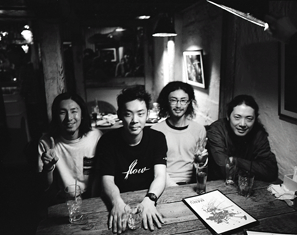
L to R: Kageyama Kanade, Kawakami Yu, Horikawa Itaru, Yamamoto Hiraku
|
Nabowa is young, relatively unproven and perhaps not yet entirely confident of their keen abilities. When I first saw them, however, I was reminded of a time when I used to watch a young fledgling act in my hometown called The Dave Matthews Band. You could hear their promise 20 years ago. World tours, sold-out concerts, MTV awards and many Grammys later, they have confirmed that a new, distinct sound on the live circuit can elevate a band to national recognition before record execs even discover them. Both bands have violinists, but that’s not why I recalled that feeling of discovery. Very early in their career, too, Nabowa has style, so difficult to achieve, but without which art is just imitation. Hailing from Kyoto, band members Yamamoto Hiraku (violin), Kageyama Kanade (guitar), Kawakami Yu (percussion) and Horikawa Itaru (bass) protest when I try to label them a jam band. “We are aware of great jam bands,” says Kawakami, “but we don’t try to place ourselves in that tradition. We play the music we like—what sounds good to us.” It was a fair qualification. Their sound resonates with many genres, reflecting the individual members’ varied tastes in music. When I try to pin them down on their conscious influences, they produce Steve Vai (Yamamoto), The New Masters Sounds (Horikawa), Mice Parade (Kawakami), and Cornelius, Rovo and Special Others (Kageyama). A full-length set features flavors of folk and bluegrass, new age, reggae, jazz, pop, ambient, lounge and, yes, rock. The space in their songs and lyricism in their melodies also vaguely remind me of U2. The guitarist can get down and nasty, blues-rock style, when the moment calls for it, which is important for another reason; Nabowa doesn’t have much of a stage presence yet. They seem introverted and particularly focused on their music, but larger crowds in the years ahead may draw that intensity out. After playing a university music festival, the current four members began to meet for sessions. These continue to play an important role in their song-writing process as members bring their ideas and build from there. They all immediately note their current challenge is the labor in putting together their next full-length album, the intimidating sophomore album. Although instrumental until now, they plan to include a vocalist. They do already have a second full-length album of remixes. “When DJs reinterpret our songs, they come out completely different.” Nabowa completes the circle by using these as inspiration and re-performing them live. If you are interested in hearing a sound that transcends not only Kyoto’s local music scene, but national borders as well, do complete another circle by seeing Nabowa live. www.myspace.com/nabowa |
Nabowa(ナボワ)はまだ初々しささえ感じさせる若手バンド。本人たちもまだ自分たちの素晴らしい才能に100%気付いていないかもしれない。でも初めて彼らのライブを体験した時、僕はデイブ・マシューズ・バンドという若手バンドを昔地元で観た時の気持ちを思い出した。将来を期待されて彼らが登場したのはもう20年前のこと。今ではワールド・ツアーを行い、ライブチケットは売り切れ、MTVアワードに数々のグラミー賞を受賞するところまで登りつめた彼らだが、独自のパフォーマンスでライブを積み重ねていくことが成功のカギであることを彼らは証明してみせた。この2つのバンドにはバイオリンが入っているという共通点があるが、それが理由で昔観たデイブ・マシューズ・バンドを思い出したわけではない。独自のスタイルを打ち出すのはとても難しいことだけど、それが無ければ物まねになってしまう。そしてNabowaは最初から独自のスタイルを持っているのだ。
山本啓(バイオリン)、景山奏(ギター)、川上優(パーカッション)、堀川達(ベース)という4人のメンバーは全員京都の生まれ。ジャム・バンドと呼ばれることには抵抗があるという。「素晴らしいジャム・バンドをいくつか知っていますが、僕らが目指している音は違うところにあります。自分たちが心地良いと感じる音楽をやっています」と川上は言う。確かに彼らの音はメンバー全員の幅広い音楽的な好みを反映していて、様々なジャンルを取り入れたものだ。影響を受けたアーティストを聞いてみると、スティーブ・ヴァイ(山本)、ニュー・マスターサウンズ(堀川)、マイス・パレード(川上)、コーネリアスとロヴォとスペシャル・アザース(景山)、という答えが返ってきた。ライブではフォーク、ブルーグラス、ニューエイジ、レゲエ、ジャズ、ポップス、環境音楽、ラウンジ、そしてもちろんロック、など様々な要素を持った独自の音を聞かせる。その叙情的なメロディーは何となくU2を連想させるところもある。ギターの景山はブルースロックっぽい感じの音を出すこともあり、それがまたとてもカッコいい。彼らはまだあまり頻繁にライブをやっていく感じではなく、云わば内向きに自分たちの音を追求しているように見えるが、これからライブを重ねていけば、多くのファンに刺激されてステージで内に秘めた激しさを爆発させるようなパフォーマンスを見せてくれるようになるかもしれない。 大学祭での演奏を終えた彼らは話し合いを始めた。メンバーそれぞれがアイデアを持ち寄って曲を書いたり、構想を練ったりするためのミーティングは大事なプロセスだという。現在彼らは2枚目となるフルアルバムの製作に集中しているところで、新作ではボーカリストを入れることも考えているという。リミックス・アルバムとしてはすでに2枚のフルアルバムが発売されている。DJの手に掛かると全然違った曲に生まれ変わるという。そしてDJによるリミックスからまた新しいヒントを得たり、そのアレンジをライブに取り入れたりしている。京都のローカル・シーンを超えて国境までも越えるような音を創造するNabowaのライブを是非体験しよう。 |
Dachambo
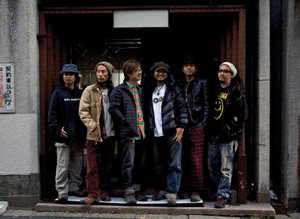
L to R: Hata, Omi, Eiji, Yao, Billy Bukka, Ao
|
Make no mistake: Dachambo is the ultimate post-rock jam band in Japan. Live shows are their raison d’etre, and their devoted touring schedule carries them to the far corners of the country, not just the big cities. They seem aware of their role as jam band torch-bearers and actively try to cultivate a ‘scene’ by encouraging dancing, live taping and all around good cheer. The crazy cosmos of fans that follows jam bands on the road in the U.S. is a phenomenon that doesn’t exist in Japan, in part because the country’s limited size prevents extensive tours dates, but Dachambo is a band that could pull it off. With infectious energy and a remarkable musicianship, each live show is a psychedelic spectacle of the moment.
Dachambo includes Hata (keyboards), Eiji (bass), Ao (guitar), Omi (digeridoo), Yao (drums) and Bukka Billy (drums)—a twin drum section! They started out in 2001, “kind of accidentally,” says Ao. Two members jammed together and the band honeycombed to six from there. Even Omi’s choice of instrument was accidental. “I originally heard the digeridoo while traveling in India. I wasn’t sure what I wanted to do with myself, but when I went to Australia, I decided to pick it up.” At any given show you may even see the members trade instruments. Emotional and economic survival is a daunting task for any new band, especially one with six members. “We just have to move forward. But we all get along fairly well anyway,” comments Ao. They admit that after a show they may snipe at each other for mistakes, but laugh that with six members, the blame thins out. They have been able to grow through friends and connections, a network of fans who spread the word about their sound and style. I know what the naysayers say about jam music; it’s long-winded, repetitive and boring. And a friend who played with Dachambo years ago remarked that they didn’t seem able to build to a proper crescendo. That was then, I’m sure. Their New Year’s Eve concert was one of the more impressive improv performances I’ve experienced—yes, experienced—and I’ve been privileged enough to see acts like Santana and the Grateful Dead (alas, never Zappa). Dachambo reaches a frenzied pitch and passes through different keys before bringing the song crashing down to its often-surprising resolution. Toward the end of the long evening, they did begin to lag some, but continued jamming because the die-hard fans wanted it. In an age of digital theft, this vibe is one thing nobody can steal, and few, if any, can replicate. www.dachambo.com |
ダチャンボは日本が宇宙に誇るサイケデリック・ジャムバンド。ライブをこよなく愛し、日本の津々浦々までツアーして回る。ジャムバンドのリーダー格であるという自覚を持ち、最高のパワーでジャムバンドの世界を広めるべく精力的にライブ活動を続けている。アメリカには長期間に亘って国内を旅するジャムバンドがたくさんあり、彼らを追い掛けながら一緒に旅をするファンもいるのだが、日本は狭いからそこまで長期間のツアーはあり得ないし、従って長期間の追っかけファンも存在しない。だがダチャンボは例外。凄まじいまでのエネルギーと優れた音楽的才能のおかげで、彼らのライブはいつも興奮した観客でトランス状態だ。
メンバーはHata(キーボード)、Eiji(ベース)、Ao(ギター)、Omi(ディジェリドゥー)、Yao(ドラム)、Bukka Billy(ドラム)、という珍しいツインドラム編成。結成は2001年、Aoいわく「偶然集まった感じ」だったという。まず二人がジャムり始め、その輪が広がって現在の6人になった。Omiがディジェリドゥーを選んだのも偶然のようなものだったらしい。「インドを旅行中に初めてディジェリドゥーの音を知ったのですが、その時はまだその楽器をやろうと思ったわけではありませんでした。その後オーストラリアに行った時にこれをやろうと決めました」。ライブではメンバー同士で担当楽器を交換して演奏したりもする。 新しいバンドの場合は特に、やる気を持続させることも金銭的なことも大きな問題になる。6人もメンバーがいればそれだけお金もかかる。「とにかく続けるしかありません。もともと皆仲がいいですから」とAoは言う。ライブの後はお互いのミスを非難し合うこともあるらしいが、最終的には必ず笑顔で和やかな雰囲気になるらしい。彼らはたくさんの友人や口コミで彼らの音やスタイルを広めてくれるファンたちのお陰で人気は順調に上がってきている。 ジャムバンドの音を嫌う人たちはその理由を、長ったらしくて繰り返しばかりで退屈だからだという。何年か前にダチャンボと一緒に演奏したことがある知人は、彼らは曲の中で盛り上がりをうまく作れないような感じだった、と言った。それはきっとその時たまたまそうだったのだろう。僕は今まで幸運にもサンタナやグレートフル・デッドといった素晴らしいミュージシャンのライブを見る機会に恵まれたが(フランク・ザッパを観れなかったことだけが残念)、大晦日に行われた彼らのライブでのインプロビゼーションは今まで僕が体験したライブ・パフォーマンスの中でも最高レベルの出来だった。演奏が激しさを増してくると曲のキーが途中でどんどん変わっていったりして収拾がつかなくなりそうになりながら最後にはなぜかまとまって解決音に落ち着く、といったこともよくある。長時間のライブが終わりに近づいた頃ちょっとペースダウンした感じがしたが、熱狂的なファンたちに押されて彼らは即興演奏を続けた。ネット上では音楽の違法コピーが横行しているが、ライブでしか体感できないこのノリの気持ちよさは違法コピーしようがないし、最高のトランス感は誰にも真似できないだろう。 |
Dachambo’s new live DVD, Eclipse Road 2009, is available, however, if you just can’t catch them live.
Special Others
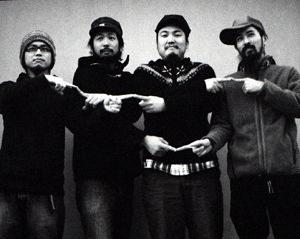
L to R: Serizawa Yuma, Yanagashita Takeshi, Miyahara Ryota, Matayoshi Yuya
|
I was apprehensive as I watched Special Others live for the first time. I had been listening to their CDs almost like an addiction for the nearly two years since discovering their video for “Star” late one night, and I was keen to see them transform their clean studio sound into an even better live performance. Several songs into their set at Fukuoka’s 2009 Sunset Live festival they finally hit their groove and the packed crowd began to undulate. Shooting from a corner of the stage, I looked to my side to find Furuya Kenji and other members of Dragon Ash, visibly impressed by the spectacle. From what I’ve heard, their respect for Special Others is generally shared in the Japanese rock community.
The jazz-rock quartet’s recent sold-out tour culminated with an extra show at Bay Hall, so they could finish in their hometown of Yokohama where it all started for them. The first set charged the house. The second set? That word again: supernova. A week later, after a session at their studio (also in Yokohama), Miyahara Ryota (drums), Matayoshi Yuya (bass), Yanagashita Takeshi (guitar) and Serizawa Yuma (keyboards) sat down to relate their remarkable journey from scrappy high school band to legend in the making. Success came after much struggle and sacrifice. All four reminisce about the long, hard years, when they had to keep their day jobs but play gigs at night, getting little, if any, sleep. Serizawa worked at a pizza shop, Miyahara worked at a soba shop, Yanagashita was a construction worker, and Matayoshi was a fisherman. As Serizawa relates, “Around 2000 we all started to take ourselves more seriously. It was never explicitly spoken among us, just felt in spirit—let’s give this a go!” But it wasn’t until 2005, with the release of their 2nd EP Uncle John, that they were able to concentrate entirely on their music. Their sound is typically bright and fast-paced. When asked about their influences, Miyahara notes, “All the various CDs that we listen to while recording bear on our music and we listen widely.” When pressed, they give a shout out to African pops and Big Frog. They are also kindred spirits with the likes of Soulive, Galactic, maybe even Charlie Hunter—jazz-funk-rock acts with a head-bobbing groove. A friend once complained that they are like a repetitive wall of sound. Maybe. But I think the looping motifs sound like American minimalism (as in Philip Glass) gone electric and happy. Special Others is currently focusing on the next tour and CD release. Serizawa confesses that overseas gigs would be financially risky, but that they would go if invited under the right conditions. For now, though, they are happy to be where they are. “We love Yokohama, we can’t explain why—we just do.” |
Special Othersのライブを初めて見たときは鳥肌モノだった。2年くらい前に“Star”の映像を観て以来、彼らのCDを聞きまくりながら、そのクリーンなサウンドをどうやってステージで再現し昇華させるのか、とても興味があった。CDで聞いていたお馴染みの曲を初めて生で体験した去年の福岡での「サンセットライブ」では彼らも最高のパフォーマンスを見せ、会場を埋め尽くした観衆も興奮のるつぼと化した。僕がステージの袖で、演奏中の彼らを写真に収めている時、ふと気付くと傍に降谷建志を始めとしたドラゴン・アッシュのメンバーたちが感動の面持ちで立っていたのが印象的だった。Special Othersを崇拝している日本のロックバンドは数多い。
ソールドアウトとなった今回のツアー。彼らの故郷である横浜のBAY HALLで行われた追加公演でSpecial Othersはツアーの最後を飾ってくれた。ライブは前半と後半の二部構成。前半ですでに大変な盛り上がりを見せてくれたが、後半のステージはまさに「爆発的な」興奮状態。その一週間後に横浜にある彼らのスタジオで行われたセッションを終えた宮原良太(ドラム)、又吉優也(ベース)、柳下武史(ギター)、芹澤優真(キーボード)の4人のメンバーはインタビューに応じ、高校の文化祭バンドとしてのスタートから今日の栄光に至るまでの道のりを語ってくれた。今日の成功の裏には数々の苦労や犠牲があったらしい。夜はコツコツとライブをこなしながら、寝る時間を削ってアルバイトも続けなければならなかった辛い日々が続いたという。芹澤はピザ屋、宮原はそば店、柳下は建築現場で働き、又吉は漁業で収入を得ながら一緒に音楽を続けていた。芹澤は言う。「バンドの将来についてちゃんと話し合ったことは無かったのですが確か2000年頃に、このままじゃダメだ、ちゃんと音楽で食えるように頑張ろうという雰囲気になって・・・」。しかし本格的な音楽活動を始められるようになったのは2005年のミニアルバムUNCLE JOHN発表以降のこと。 彼らのサウンドは明るく、テンポのいい曲が多い。影響を受けたバンドやミュージシャンについて宮原は「レコーディング中に聞く色々なCDからも影響を受けますし、僕たちは皆ほんとうに何でも聞く感じです」と言う。忙しいときでもアフリカン・ポップスとBIG FROGは聞いているという。また彼らのサウンドは例えばソウライブやギャラクティック、チャーリー・ハンターなど、ノリのいいジャズ・ファンク・ロックのアーティストたちと比較されることが多い。以前友人が、彼らのサウンドは反復的な音の洪水だ、と言った。その通りかもしれない。しかし彼らがモチーフを反復する印象はアメリカのミニマル・ミュージック(例えばフィリップ・グラスに見られるような)が電子音を使うようになってサウンドが明るくなったのと似ていると思う。 Special Othersは現在、次のツアーとアルバムの製作を予定している。芹澤曰く、海外ツアーは経済的に難しいが、いい条件でオファーが来たらやりたいとのこと。しかし当面は国内での活動で忙しいようだ。「僕たちは皆、横浜が大好きです。理由はうまく説明できないけどとにかく大好きな街です」。 |
